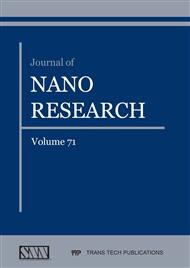[1]
B. E. Conway, Electrochemical Supercapacitors: Scientific Fundamentals and Technological Applications, N.Y. Kluwer Academic / Plenum Publishers, (1999) 698.
Google Scholar
[2]
J. Miller, P. Simon, Electrochemical capacitors for energy management, Science 321 (2008) 651.
Google Scholar
[3]
Li Li Zhang, X.S. Zhao, Carbon-based materials as supercapacitor electrodes, Chem. Soc. Rev. 38 (2009) 2520.
Google Scholar
[4]
B.K. Ostafiychuk, R.P. Lisovskiy, A.A. Saedi, B.I. Rachiy, V.O. Kotsyubynsky, P.I. Kolkovskyi, R.I. Merena, A.B. Hrubiak, Effect of orthophosphoric acid on morphology of nanoporous carbon materials, J. Nano- Electron. Phys. 11 No 3 (2019) 03036.
Google Scholar
[5]
B. Conway and W. Pell, Peculiarities and advantages of hybrid capacitor devices on combination of capacitor and battery type electrodes Proceedings of the 12th International Seminar on DLC and Similar Energy Storage Devices, Deerfield Beach. Florida (USA), (2002).
DOI: 10.1016/j.jpowsour.2004.03.021
Google Scholar
[6]
S. Devaraj, N. Munichandraiah, Effect of crystallographic structure of MnO2 on its electrochemical capacitance properties, J. Phys. Chem. C 112 (2008) 4406.
DOI: 10.1021/jp7108785
Google Scholar
[7]
P.I. Kolkovskyi, B.I. Rachiy, M. I. Kolkovskyi, B. K. Ostafiychuk, I.P. Yaremiy, V.O. Kotsyubynsky, & R.V. Ilnitsky, Synthesis and electrochemical properties of mesoporous α-MnO2 for supercapacitor applications, Journal of nano- and electronic physics 12(3) (2020) 03030-03034.
DOI: 10.15330/pcss.21.2.219-226
Google Scholar
[8]
I. Yaremiy, S. Yaremiy, V. Fedoriv, O. Vlasii, & A. Lucas, Developing and programming the algorithm of refinement of the crystal structure of materials with possible isomorphous substitution, Eastern-European Journal of Enterprise Technologies 5 (5) (2018) 61-67.
DOI: 10.15587/1729-4061.2018.142752
Google Scholar
[9]
V.S. Bushkova, I. P. Yaremiy, V.I. Kravets, & S. I. Mudry, X-ray analysis of nickel-cobalt ferrite nanoparticles by using Debye-Scherrer, Williamson-Hall and Ssp methods, Journal of Physical Studies 20(1-2) (2016) 1702-1-1702-7.
DOI: 10.30970/jps.20.1702
Google Scholar
[10]
L. Kienle, H. J. Deiseroth, SnAl6Te10, SnGa6Te10 and PbGa6Te10: superstructures, symmetry relations and structural chemistry of filled β-manganese phases, Z. Kristallogr., 213 (11) (1998) 569– 574.
DOI: 10.1524/zkri.1998.213.11.569
Google Scholar
[11]
O. Cherniushok, R. Cardoso-Gil, T. Parashchuk, Y. Grin, K. T. Wojciechowski, Phase equilibria and thermoelectric properties in the Pb–Ga–Te system in the vicinity of the PbGa6Te10 phase, Inorg. Chem. 60 (4) (2021) 2771–2782.
DOI: 10.1021/acs.inorgchem.0c03549
Google Scholar
[12]
S. Geller, Crystal structure of the solid electrolyte, RbAg4I5, Science 157(3786) (1967), 310-312.
Google Scholar
[13]
K.S. W. Sing, International union of pure commission on colloid and surface chemistry including catalysis reporting physisorption data for gas / solid systems with special reference to the determination of surface area and porosity, Pure Appl. Chem. 57(4) (1985) 603-619.
DOI: 10.1351/pac198557040603
Google Scholar
[14]
I.V. Horichok, L.I. Nykyruy, T.O. Parashchuk, S.D. Bardashevska and M.P. Pylyponuk, Thermodynamics of defect subsystem in zinc telluride crystals, Modern Physics Letter B 30(16) (2016).
DOI: 10.1142/s0217984916501724
Google Scholar
[15]
R. Ahiska, D. Freik, T. Parashchuk, I. Gorichok, Quantum chemical calculations of the polymorphic phase transition temperatures of ZnS, ZnSe, and ZnTe crystals, Turkish Journal of Physics 38(1) (2014) 125-129.
DOI: 10.3906/fiz-1301-7
Google Scholar
[16]
D. Freik, T. Parashchuk, B. Volochanska, Thermodynamic parameters of CdTe crystals in the cubic phase, Journal of Crystal Growth 402 (2014) 90-93.
DOI: 10.1016/j.jcrysgro.2014.05.005
Google Scholar
[17]
P. I. Kolkovskyi, B. K. Ostafiychuk, M. I. Kolkovskyi, N. Y. Ivanichok, S. S. Sklepova, & B. I. Rachiy, Mechanisms of charge accumulation in electrochemical systems formed based on of nanoporous carbon and manganese oxide, Physics and Chemistry of Solid State 21(4) (2020) 621-627.
DOI: 10.15330/pcss.21.4.621-627
Google Scholar
[18]
B. K. Ostafiychuk, H. M. Kolkovska, I. P. Yaremiy, B. I. Rachiy, P. I. Kolkovskyi, N. Y. Ivanichok, & S. I. Yaremiy, Synthesis and electrochemical properties of LaMnO3 perovskite nanoparticles, Physics and Chemistry of Solid State 21(2) (2020) 219-226.
DOI: 10.15330/pcss.21.2.219-226
Google Scholar


